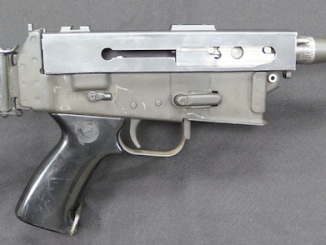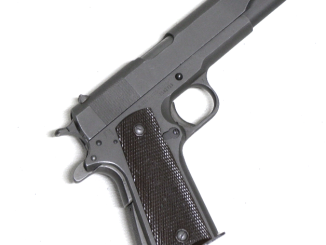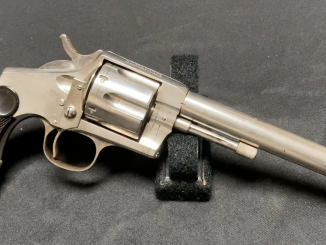These rifles are selling at Rock Island on November 30 and December 1, 2018 – the 5.56mm Model 392 brought $4,600 and 7.62mm Model 323S brought $3,738.
The Israeli Galil
The Galil was the result of a program to replace the FAL in Israeli service after its somewhat disappointing performance in the Six-Day War of 1967. Israel found that while the FAL had shown reliability problems in the desert, AK rifles ran just fine despite often being badly neglected. In an initial series of tests, captured AK rifles came out superior to M16 and Stoner 63 rifles. This led to a more extensive series of tests and developmental work in which Yisrael Balashnikov developed a number of prototype rifles based on AK actions modified to 5.56mm using Stoner barrels and magazines. This second trial would ultimately compare the M16, Stoner 63, HK33, AR18, Beretta and Steyr rifles, and domestic developments by both Balashnikov and Uziel Gal. The Balashnikov rifles would prove the ultimate winner of the competition.
Balashnikov – whose name being so similar to Kalashnikov through pure coincidence, and who was originally born Mishmar Hayarden in Russia – would change his name to the more Hebrew sounding Yisrael Galili, and the new rifle pattern would be named the Galil after him. While the prototypes had been built on captured Soviet-bloc AKs, the production version would be based on the Finnish Rk-62 Valmet receiver. The Galil featured a great many improvements and additions to the AKM, including much better rear-mounted aperture sights, night sights, integral bipod (on some models), folding stock, ambidextrous safety and bolt handle, folding carry handle, and of course, a bottle opener. The Galil was formally adopted in 1972, but never did completely equip the Israeli Army, as surplus M16 rifles form the US were available for little or no cost. It was phased out by about 2000 and replaced by the Tavor series.
Prior to 1989, semiauto Galil could be imported into the US for commercial sale, and between 7000 and 9000 were brought in by a succession of importers (Magnum Research, Action Arms, and Springfield Armory). A 7.62mm NATO version of the Galil was introduced in 1983, which was not used by the Israeli military but did see adoption by Colombia as well as limited commercial sale in the US. The standard 5.56mm Galil were purchased by an array of foreign militaries including Guatemala, Nicaragua, Estonia, Portugal, and South Africa (where it served as the basis for the domestic production R4 series).




I notice that when the stock is folded the ejection port is clear but the AK style safety is blocked when down in the ‘fire. position. I wonder if that is why the left side safety was added?
“night sights(…)folding stock”
Actually folding stock variant of АКМ named АКМС was adopted in 1962, 3 years after basic АКМ.
Also there existed “night” version of АКМ named АКМЛ where last letter stand for ласточкин хвост = dovetail [joint], it has also special flash-hider to prevent damage of night sights from muzzle flash.
Also there existed folding stock variant of АКМЛ named АКМСЛ.
Also, keep in mind that Soviet Armed Forces adopted rifle night sight as early as 1952.
It was called НАП1, see drawings: http://www.ak-info.ru/joomla/index.php/devices/9-optics/98-nap1about
Due to state-of-art of Soviet 1950s technology it is heavier and shorter-ranged that 21th century night vision: НАП1 itself weighted 2,35 kg while battery pack weighted 5,150 kg. It had range 100…250 m depending on target type. Length of wire between pack and sight was 1,3 m.
It could be used together with: 7,62-mm Kalashnikov’s Avtomat, RPD or RPG-2.
The rifle I would like to see more about is the one Uzi Gal developed. I’ve heard just enough about it to be intrigued, and an Israeli involved (so he said, anyway…) in the testing insisted it was the better rifle, lighter, more durable, and more reliable than the Galil, but that politics had interfered, and the Galil won when it really should not have.
I am not aware that U.Gal had ever developed a competitive model to Galil; neither heard /read any comment by him in that respect. As capable man he was I feel more is subscribed to his credit than he could actually carry. All I know he was critical of Galil.
In general sense, what was done to AK in form of Galil might be impressive in many regards, but it is overall not a practical 5.56mm rifle, main reason being its clumsiness/ excessive weight. Russians themselves were very aware of this fact and you can see that after introducing sheet-metal based AKM, they never switched back to milled receiver.
Ask yourself a question: while Galil is weapon of past the AK still lives on. Why is that?
“I am not aware that U.Gal had ever developed a competitive model to Galil”
For technical-tactical data see Gun Wiki query:
http://guns.wikia.com/wiki/Gal_rifle
For how it works see video in thefirearmblog post (2nd video from top):
https://www.thefirearmblog.com/blog/2014/12/23/uziel-gal-rifle/
Thanks for enlightening me, I will look at it closely.
Hmm, so I looked at both videos and my impression is this is a unique source. Couple of highlights of Gal’s rifle:
– sheet metal receiver
– replaceable barrel
– replaceable trigger pack
If appears that what he intended was more than a rifle – it was a set permitting to build anything from carbine to LMG. Very forward thinking, which was not (part of Stoner 63) seen yet. Why this was not adopted is beyond me.
IMHO, it was a bit more complex than Galil. Taking into account the lack of interest in carbine or LMG, the additional trigger variations etc. were probably seen as a disadvantage
“while Galil is weapon of past the AK still lives on. Why is that?”
Because Israeli decided to abandon further development of their Galil, while Russians did not so in regard to AK, so it evolved into AK-12 and AK-15 for example, see videos here:
Shooting: https://kalashnikov.media/video/weapons/wargonzo-testiruet-ak-12k-i-ak-15k
Disassembly: https://kalashnikov.media/video/weapons/sborka-razborka-avtomata-ak-12
Another shooting: https://kalashnikov.media/video/weapons/larri-vikers-testiruet-ak-12
In that last, shooter say after firing that he appreciate way of mounting rail.
One commenter under video quite appropriately said: “detskiy sad” 🙂
By far the best AK tester is Larry Vickers. He does less talkin’ and more shootin’.
In retrospect, and this is my speculation, it may have been part (I am aware there were family matters as well) of Uzi’s decision to leave Israel and try luck in United States. After all, even this did not work for him that well.
“Israeli decided to abandon further development of their Galil, while Russians did not so”
Seriously?
IMHO it’s not about subsequent development, it’s all about the original guns themselves and the marketing of course))
the micro galil and the improved galil meaning the ace galil are still alive and shooting and much better then the original ironing out the flaws
unlike like the ak that continues with the same flaws and errors and cheap workmenship
if you want low cost then choose ak and the quality will be the same
there are several ak version that are high quality and the price is accordily
It’s hard to believe, this time Wikipedia is more reliable source than Forgotten weapons.
https://en.m.wikipedia.org/wiki/Yisrael_Galil
Ian, thank you for the great video. It’s fantastic as always, save that minor mistake with the name.
“Balashnikov – whose name being so similar to Kalashnikov through pure coincidence, and who was originally born Mishmar Hayarden in Russia – would change his name to the more Hebrew sounding Yisrael Galili”
Source? Most wikipedia queries including HEBREW one states he was born in The British Mandate of the League of Nations for Palestine.
Im puzzled by this too, wtf is this “Balashnikov” if he is born Hayarden ?
Maybe a nickname ?
But most of all to me, sounds like BS
From query in Deutsch wikipedia it looks that Mishmar HaYarden was actually place of birth. Also it says that his family was from Soviet Union, which would explain Balashnikov name. Interestingly it also say that IMI Galil was co-developed by him and Yaakov Lior.
When one looks at it from a different perspective, its fascinating that change is not just in persons surroundings, from one place to far away another, but even in a completely different name, like they were (trying to) invent(ing) a new nation.
Good though isn’t it, the Balashnikov.
Grand Duchess Elizabeth Feodorovna told Sergei it was a god almighty “cock up” forcing the Jews out. But he did, so it is no wonder they created/went to Israel.
Why are you surprised; did they just deserve it for being different?
Mishmar Hayarden (Heb: משמר הירדן) means “Guardian of the Jordan” and is a small moshav in the north of Israel, very near the Jordan river and the town of Rosh Pinna. It is NOT a Russian sounding name and it was not Balashnikov’s name.
“Balashnikov” was indeed Galili’s original name. He was born in Mandate Palestine, likely in Mishmar Hayarden. Many Jewish families in Palestine that arrived in the main “aliyot” (waves of immigration) came from East Europe and had Eastern European names – Balashnikov would be one of those. Many of them or their children Hebraicised their names – and so Balashnikov changed his name to Galili.
That makes more sense than anything, except that Balashnikov is absolutely not a Jewish name, not in Yiddish (German) and not in Hebrew. Plus, unlike Kalashnikov, it does not have any Slavic roots in it even if it sounds perfectly Slavic. So it’s either an inside joke or a really weird coincidence. Also “Galili” with an I in the end, or rather a Yud, is kind of a Sephardic name, not so much what an Ashkenazi would come up with, like Uzi Gal / Gotthard Glas, for instance. (I’m a Russian/Ukrainian/Israeli). There’s definitely some mystery behind the wordplay.
I remember hearing the obituary on the Israeli Radio and I think they called him Uziel Galili and they did mention Balashnikov as his other name… I might have misheard it so it could’ve been “Israel”, which in Hebrew would be “Srul” for short… They did mention his involvement with both the Galil and the Uzi. So I kind of assumed he was the same person as Uzi Gal back then, which is not the case.
It is very unlikely for anybody to immigrate to Palestine (or to any other place) from the Soviet Union in the 20s and the 30s. So he probably was born in Palestine. Mishmar Ha-Yarden is definitely a place in Israel, not a personal name.
As far as a rifle itself it’s a terrible and unsafe 5.56 rifle. I was in one of the last Israeli Marines units that were issued those in the early 90s and we hated them. We didn’t have handles on them and the first thing we were required to do was permanently removing the bipod. It still weighs like a machine gun, especially with coupled magazines we all used. It required a ton of cleaning after shooting. We were very happy when issued M4 s (Vietnam-era ones, no brass deflectors) after the first 4 months of basic training. It’s obviously 4 times lighter and more reliable safe and accurate. And obviously, this being Israel, we were not allowed to ever shoot an assault rifle on automatic. Matter of fact in my 3 yeas in the army I have never seen an assault rifle shot in auto mode. (I was a MAG machinegunner myself).
The short version (Glilon) was popular with tank crews because nothing would happen to it if you leave it on the floor and through a box of tank ammo on it… But they never had to actually carry it on a 70 kilometer march…
Galil was replaced in combat units (Givati, Golani, Nahal and Paratroopers) by mostly M16 around 1994. Most elite units (like Sayerets within the aforementioned units etc) were already using M4 for many years prior to that (and Shayetet, our Navy seals equivalent, had AK 47 plus other specialized guns). Right before that there was an attempt to fit red dots on Galils but that didn’t make them much better, mostly a bit heavier and higher maintenance. Eventually, in the beginning of the new century, Israel switched to mini-Tavor (for most combat troops), which is arguably not as great as an AR-15 platform. They experimented with the full sized Tavor for a bit and it was obviously not a practical gun by any standards.
most people from pre israel were originated from eastern Europe and Russia
so a russian name is not an odd matter at all
even I have a russian username even though I was born in south Africa
It’s really interesting why you chose that particular name.
like in most cases i dont get to choose my own name… it is give to me
In this connection it is worth of taking look at East German made AKM, probably the best from bunch. Note the furniture – this is a class on its own.
https://www.youtube.com/watch?time_continue=343&v=B0uXF2ZqeYY
Yeah, I’ve been using AK’s in one variant or another since 1977, carried them many times in front of the wire in Iraq (both wars), and had access to a LOT of them in Iraq. Denny is right, the East Germans are probably the nicest of the bunch although I never cared for their furniture. I purchased a 392 Galil back in 1988 with a 16 inch barrel which I still have, however I removed the bipod and handguards and made it an AR (kept it all though). Ian didn’t mention it but a straight up Galil ARM even in 5.56 is a heavy damn gun. I was in Israel in 1985 and an IDF captain told me that putting bipods on the Galil was a huge mistake as troops tended to treat the rifle like an LMG and burned out the barrels. The pistol grip was copied directly from the AMD-65. The two best AK variants extant IMO are the IMI Galil and the Valmet M-62.
served in the israeli army early 90 with the damn heavy galil. there might be various issues with the bipod due to most the bipod in 97% of the time was just used so the rifle will not be place on the ground.
in any case using as LMG would be a complete misuse of the rifle in israeli warfare doctrine
“The Galil was formally adopted in 1972, but never did completely equip the Israeli Army, as surplus M16 rifles form the US were available for little or no cost.”
some corrections, the galil was adopted mid 70’s, the AR (ARM) and SAR into the infantry units, the SAR into the tank and artillery units.
the M16 was adopted into non combat and reserve units only.
the infantry units used the AR/SAR unitl 1992 only, when the M16/M4 was adopted. tank and artillery units used the SAR into the 2000’s.
the MAR is still use by the israeli police.
no carrying handle.
the bottle opener in BS.
the gun is heavy but not too much, it is extremely reliable like the AK. the only big problem is the accuracy.
Can anyone say for how much both the .223 and the 308 were auctioned for in this clip?
https://www.youtube.com/watch?v=SLDw6i1D52U&t=57s
One correction to your history. I served in the IDF from 1986-1990 and the Galil in fact “WAS” the standard issue rifle. There was a Galeilone which was a shorter (SMG) for NCO’s and a short M-16 which looked like an automatic AR-15 for officers.
Very common in SA, Russian and Lithuanian names in Jewish society!